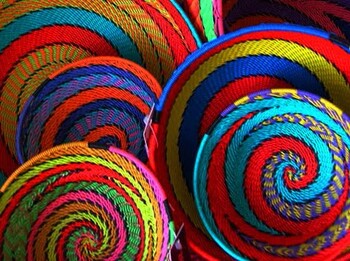Substitution Weaving

Substitution weaving is the process of using a different combination of threads to create textiles or fabrics during the weaving process. The whole idea behind substitution weaving, as the name suggests, is about taking one kind of thread and replacing it with another. That means, everything that would normally happen with one particular kind of thread, now is done by another, which is basically where the word substitution comes from. Changing the basic ways of traditional weaving, this technique gives a fresh direction to the whole process.
When talking about substitution, we aren't really talking about using another, external, thread and adding it to the mix, because that would be the same as using the same thread and going on. What we are talking about is replacing the wefts and the warps to or substituting them with each other while using the same overall concept.
Weft Substitution Weaving Process
For many centuries, the weavers from Morocco and Algeria, as well as those from Persia, Algeria, Baluchistan and Turkmenistan, have followed the principles of weft-substitution weaving in their art-form. While they were originally creating simple plain weaves, slipping coloured consider, Blacksmiths wefts made things more beautiful look at, RC Quadrocopters and pleasant to the eye. The structure of the entire fabric was designed to be the same when it came to strength but the difference came in the way the final design look at, CB Radio - Citizens Band Radio would look.
Most weavers used this process to produce some extremely fine-patterns, mainly geometrical, although these were always created by hand. The loom was rarely used in this process because there was no real help coming from the entire process. One of the key characteristics, however, was the difference in the way Moroccan weavers always worked on the fabric from behind while the Asians had a front-on approach.
As in the case of tapestry, weft-substitution weaving is a pattern where warps can only be seen at the fringes of the cloth! The wefts are, first, of one colour look at, Mobile CB Radio and then the other is brought in to form an intricate pattern. The unused yarns, in the process, are allowed to float around on the other side of the fabric, allowing the weaver to choose whether they would like to leave them there or trim them off and leave the ends hanging loosely.
If you happen to notice these patterns in a crosswise format, then that is most likely due to its origins from the Baluchistan or Turkmenistan regions. Weft-substitution weaving is extremely popular with these kind of contrasting textures and many people, including Moroccan weavers, have managed to take the designs try, RC Hexaflyer to great depth and detail.
Warp Substitution Weaving
When you take weft substitution and switch things around such that the warps are substituted in each step instead of the wefts, you get the warp substitution method. In this form too, it is plain weaving fabric that has its threads substituted and replaced with other warp-threads and the entire fabric changes why not visit, Wood Carving Chisels and Gouges its patterns accordingly. The warp threads on these fabrics are visible above everything else and that ensures easier substitution as well as a warp-heavy design. have a look at, CB Radios
Each warp yarn has to be spun extremely tightly before being plied tightly as well. That is followed up by jamming the entire setup of yarns close to each other on the loom, so that as the fabric is woven, the wefts keep getting hidden behind the warp threads. Each warp is, then, left loosely hanging at the back of the fabric once they are no longer of any use in the pattern. Warp substitution weaving has been used over and over again, in the process of making tent bands or simply sturdy covers for objects.
There is, however, one major drawback to this kind of weaving style wherein the warps are required to maintain a certain minimum degree of tension. That means, they need to be placed in equal proportions, with the right kind of spacing and in perfect tension. So, if you are using contrasting threads or substituting existing threads for others, then you need to maintain that level of tension and tightness in the entire process, meticulously adding every thread to its rightful place have a look at, CB Weather Radio Guide and ensuring that there are no gaps in the entire setup.
These two forms of substitution weaving are one of the most important styles in the entire hobby of weaving. There are always many new things to learn in this hobby and amongst the slightly more advanced-level techniques, substituting warp and weft threads allows you to make more intricate patterns with a wider array of colours. , Chocolate Cake So if you are looking for a way to expand your horizons in weaving, then substitution weaving is worth a look.
 RC Boat Videos RC Boat Videos
RC boat videos are a great way to get a hang of radio controlled boats. Dealing with all aspects of |
 Collage Art Collage Art
Collage art is an interesting hobby and is practiced by many enthusiasts all over the world. Collage |
 Brewing Bulwark American Lager at Home Brewing Bulwark American Lager at Home
Brewing Bulwark American Lager is a great way to enjoy a popular version of American Lager. This dee |
 Clove Oil Clove Oil
Clove Oil has so many wonderful and practical applications varying from the traditional use of treat |
 CB Radio Antennas CB Radio Antennas
Some have said that the most important parts of CB radio kits aren't the radios themselves - they're |